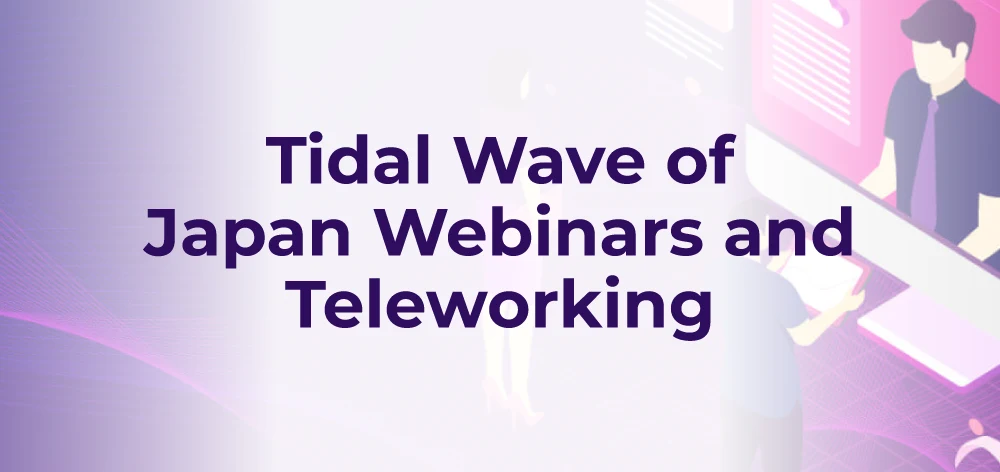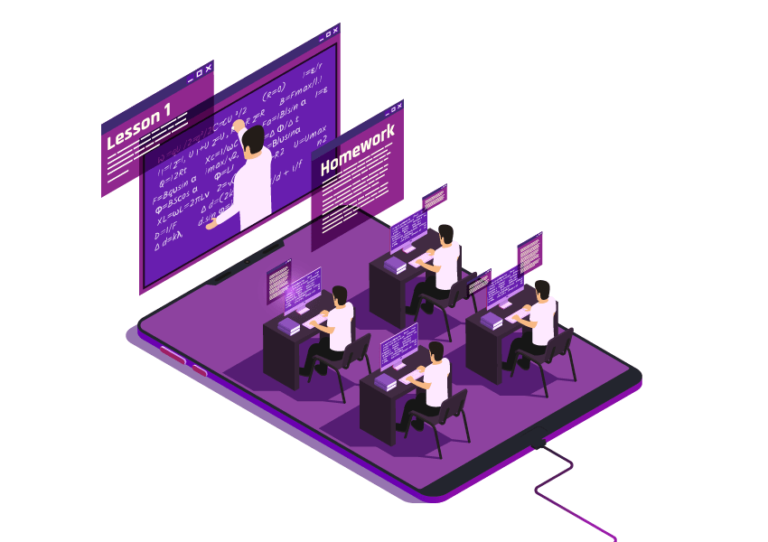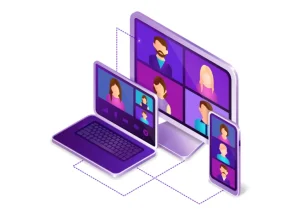September 23, 2024
|5-minute read

The global pandemic has changed the landscape of homes and workplaces everywhere. Economies have plummeted, lifestyles have changed, and work habits have been transformed to fit the global fight against coronavirus disease. In Japan, the government has instituted drastic measures to contain the pandemic, including instituting social distancing policies, requiring the use of face masks in public spaces, and even postponing mass gatherings, including the 2020 Summer Olympics in Tokyo.
Teleworking is seen as one of the most effective ways to fight the virus, as it restricts people’s movement and thus prevents the spread of the virus among people in transit or in public spaces. In this setup, the Internet facilitates productivity: information workers collaborate, meet, and do work through software, including video conferencing apps such as Zoom and Google Meet, as well as business communication tools such as Slack, Microsoft Teams, ChatWork, and – of course – email. Video conferences take the place of in-person boardroom meetings, and workers use online software – connected remotely via the Internet or the cloud – in lieu of the traditional desktop. Telework has proven to be a viable alternative to the traditional office – a deliberate response to the “new normal”.
One of the biggest shifts that have affected the telework culture in Japan is the cancellation of mass gatherings. While the most obvious culprit here would be sports events, this also means that business-related functions have been cancelled or postponed. These include meetings, luncheons, conventions, and seminars – all essential parts of the traditional office culture where people can create networks, discuss ideas, and learn new skills.
It is not surprising, then, that the demand for virtual events in Japan is at its highest ever. Web conferencing alone is experiencing an upsurge in interest and demand, due to the necessity of communicating and staying in touch virtually. Digital content consumption, on the other hand, continues to rise as Japanese people continue to spend more time at home. Some analysts have coined this seismic shift as the “Godzilla Effect”, after the fictional gargantuan reptile that has affixed itself to Japanese culture.

A June report from data analytics firm Nielsen found that in March 2020, Japanese spent 78% more time reading news online relative to the same month last year. 20% of the Japanese market are also spending more time watching online videos or streaming than they used to. Responding to increased demand for digital content, firms have shifted to virtual channels as the primary allocation for advertising and engagement campaigns. These companies are merely advertising where their target market can see them: online. Simply put: the Japanese market is experiencing a seismic shift to the digital space, and companies are striving to meet them there. Japan webinars are an important answer to this upward trend.
One of the ways by which firms engage with their audience during this time is through webinars. With the rise of the internet and the catalysis of the COVID-19 Pandemic, webinars have now become mainstream in Japan. This has opened up new opportunities and avenues for global companies to engage with their Japanese audience through a new digital channel. It is also a crucial way by which companies can conduct campaigns for Japan lead generation.
Today, webinars have become the new normal. In-person seminars have given way to virtual webinars. A 2020 report by videoconferencing platform ClickMeeting has traced a rise of 500% in terms of the total number of webinars hosted on their platform, with nearly 3,000,000 attendees. Data like these accentuate the need for brands to think outside the box and go beyond the traditional seminar structure. Marketers are now scrambling to identify new routes to market to their audience considering the current crisis. Japan webinars ensure that you can provide value to your potential customers. Brands can easily cover niche topics and distribute their webinar through platforms where their target market is. For example: a technology solutions provider can host a webinar on cybersecurity and anti-fraud measures (coincidentally also on the rise during the current crisis), to target businesses that are looking for those solutions to protect sensitive company data.
Japan webinars also provide an additional bonus for brands: you can become an authority in your niche, the go-to resource portal for an interested audience. If you produce high-quality visual content that can positively impact your audience – through, say, boosting their sales or providing in-depth information on a highly-specialized topic – it will be easy for your brand to establish a good relationship with your target audience. The interactive nature of Japan webinars also provides you the opportunity to seamlessly take in questions from attendees, who will, in turn, see you as an authority figure in that particular topic. And the next time they think of some specific products or solutions categories you provide, they will go directly to your company.

In Japan, webinars are becoming more and more popular. Japanese brands are beginning to implement webinars, actively shaking off the old, and shaping a new digital landscape that is more conducive to online learning and engagement. The new Japan webinar craze is quickly replacing the traditional Japanese seminar format that was a staple of regular sources of leads, usually conducted once a month. And it is not only the business community that is leaning more towards Japan webinars. Schools, universities, and other educational institutions have also shifted to a preference towards online events. Teachers have been forced to grapple with online education, while conferences, workshops, and academic congresses have become online events.
Japan webinars are particularly useful for the target market since they ignore geographical constraints, and can be executed from nearly anywhere, bridging physical divides that have hindered the traditional seminar structure. They enable brands and marketers to reach and engage a large, dispersed audience over time. Due to the very nature of webinars – hosted online, in the cloud – they may be accessed by anyone interested in your topic. In Japan, for example, our hypothetical technology company may have hosted in-person seminars in a private meeting room at the heart of Tokyo to an audience of 30 people before the pandemic. However, a webinar would allow them to reach not just the major business centers such as Tokyo, Osaka, or Fukuoka – it can engage tech startups in the whole of Japan, engaging remote regions that are also in need of cybersecurity solutions. Moreover, that webinar would release brands from the physical constraints of a venue. Whether it is 30 people or 300 or even 3,000, webinar attendee numbers are virtually limitless. These kinds of Japan webinars will ensure that brands targeting the market will maximize both reach and engagement.
Webinars are also cost-effective. While they may take some investment in time and resources, it is still cost-effective in comparison to direct advertising or a pay-per-click campaign. Many of the tools required to host webinars are free, open-source, or inexpensive and readily available. Open Broadcasting Software (OBS) Tools, for example, is a free desktop streaming software where you can create webinars after some configuration. Software such as these, together with a dedicated management and support team, will ensure a successful webinar. Although Japan webinars are being touted as cheap and easy replacements for seminars, the Japanese audience is experiencing higher production values from webinars.

featuring tools like Open Broadcasting Software
Culturally, Japanese webinars are a huge shift in how Japanese society is reacting to live video. Before, household sounds were completely unacceptable. Children, animals, noise, and technical problems were improper for any live presentation. Today, however, it has become more and more accepted, signaling a more “forgiving” audience sympathetic to presenters affected by the current crisis.
A key player in this “tsunami” towards Japan webinars is the Japanese mainstream media, particularly television. Responding to the times, Japanese television shows have also showcased interviews with their guests at home or in their personal spaces. Previously this would be considered unprofessional. But the shift towards Japan webinars have normalized this trend and has allowed a more relaxed atmosphere towards webinars.
Another key player in the rise of Japan webinars is the videoconferencing software Zoom. Being the platform of choice for webinars, Zoom has virtually exploded overnight in terms of interest. Throughout the year, search volume for “Zoom” has increased 32 times compared to the same timeframe the previous year. Before quarantine measures were put in place, search hits for “Zoom” figured about 100-200k per month. In April of 2020, however, there were a total of 8.1 million hits, stabilizing in July at 2.9 million searches. Books about Zoom, too, now litter the shelves of almost any major bookstore in Japan, catering to a need for Zoom tutorials, guidance, and references to maximize their skills in the platform. These figures and anecdotes merely point to Japan webinars being the norm through the foreseeable future, cementing itself as a crucial avenue for the Japanese market to keep in touch with brands, learn more through the Internet, and engage with companies through meaningful interactions.
Webinars are here to stay, and the Japanese market is fertile ground for brands willing to invest in this (relatively) new marketing platform. Japan webinars are cost-effective, not limited to geographical boundaries, and maximize engagement with audiences. Japan webinars, too, are currently the only way where consumers can both gain valuable knowledge, while also providing brands the avenue to collect valuable insights into consumer interest and to engage with their audience on a personal basis. It can be reasonably expected that Japan webinars will become the norm even beyond the pandemic.
No tags available for this post.
Please enter your email address so we can send you a one-time pass code and verify if you are an existing subscriber.